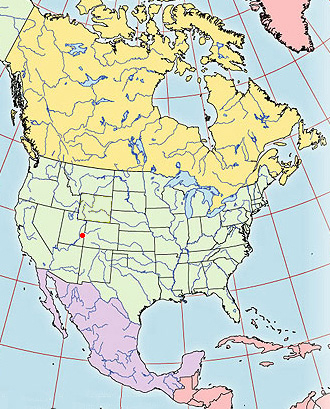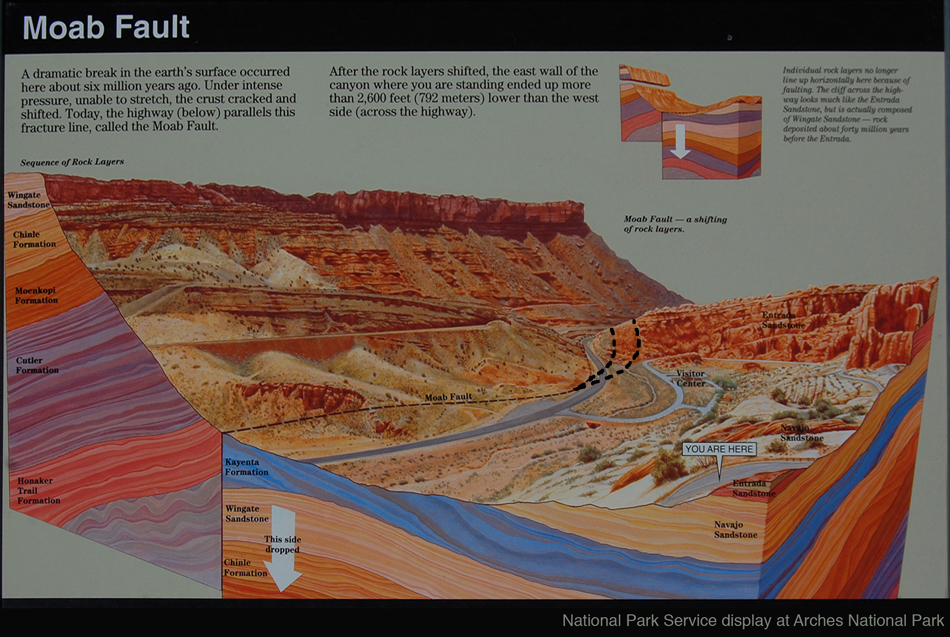|
This virtual field trip takes us to the Moab Fault, which runs essentially north-to-south just west of Moab, in east-central Utah, and just west of Arches National Park. Because the local stratigraphy will be significant here, let's begin with an overview of the stratigraphic units commonly seen in the area. The image below shows these stratigraphic units with the topographic expression that they usually display, most notably with the Wingate and Entrada sandstones forming cliffs:
|
Image 1 
|



So what does that asymmetry mean? Just the contrasting landscapes on opposite sides of a valley would suggest a fault to many geologists, with the valley hypothesized to be the result of preferential erosion of rocks ground up in the fault.
Let's continue our reconnaissance with a view from the north, looking at the same area but from a height on Gemini Bridges Road about seven miles north of Moab. Again, take a look and see what you see, before reading further.

Again, the difference in landscapes on opposite sides of a valley at least raises the possibility of a fault. The area on the left side is largely Arches National Park. Let's go into the park for a west-looking view from along the Park's road climbing up from the Visitor Center:

. . .
. . .
. . .
. . .
. . .
. . .
At this point, it should be apparent that there is a fault in the vicinity of the highway, because the Navajo-DeweyBridge-Entrada sequence would sit atop the Wingate cliffs in an undisturbed succession.
The Park Service has a nice sign illustrating all this from the same perspective as the image above, so that the image above was captured from the "you are here" point in this sign:

Of course, as geologists, we would like to see the fault up close, and the exposures along the highway should be a good place to do it. (On a virtual field trip, two bad things don't happen: no one gets run over on the highway, and the state police don't come to call.) Let's go down to look at the south side of the highway's roadcut, in the area circled in yellow on the image below:


. . .
. . .
. . .
. . .
. . .
. . .
Your examination has, we hope, revealed that most of these faults have dropped strata down to the right, and thus to the west. One fault, in the right-center of the image and below the gully on the skyline, goes the opposite and drops strata down to the left, and thus to the east.
These faults have been the subject of considerable study because of their good exposure (e.g., Foxford et al., 1998; Eichhubl et al., 2009). In part that's because faults can be avenues for migration of petroleum through Earth's interior. For example, the image below shows some of the space opened up along these faults where brittle rocks (mostly sandstones) have been fractured:

We've been looking at the spectacular exposure of small faults in the Honaker Trail Formation on the south side of U.S. 191, but maybe we should look at the north side of the highway. If we look west and compare the two sides of the road, it's evident that the same strata are exposed on both sides of the highway (and thus the Park Service's sign can't be correct in claiming that the fault follows the highway here):


This interpretation of the fault is that of Doelling et al. (2002) on their geologic map of the Moab Quadrangle, with the refinement that they split the fault into two branches, one on each side of the red rubble of Entrada. Here's the relevant bit of their map, with solid lines and "bar-and-ball" symbols (in the red circle at lower left) marking each side of our rubbly zone:


1) Long straight valleys that separate regions with contrasting landscapes can suggest the hypothesis of a fault (Images 3 to 6). That hypothesis can then be tested by looking for differences in lithology or stratigraphy across the boundary, or by looking for more direct evidence of the fault itself, such as a breccia or fault gouge.
2) Most major faults are really a zone of several faults, as was the case here (Images 9 and 12).
3) The most obvious fault surfaces may not be the most significant surfaces in terms of overall motion of rock. That was certainly the case here, where the obvious surfaces (Image 9) caused the person drawing the Park Service's sign (Image 7) to not recognize the actual surface(s) of major motion (Images 12 and 14).
4) Brecciated fault surfaces in brittle rocks can provide space for migration of fluids, such as petroleum (Image 10).
5) However, the fault surface or surfaces of most motion may be so deformed and pulverized that they are not the avenues for fluid migration (Image 12). Instead, the surrounding fault surfaces and fractures of lesser significance to displacement (Image 9) may be the zones along which open volumes are preserved to allow migration of fluids.
. . . . and we hope you've enjoyed this trip!
Bibliography:
Doelling, H.H., Ross, M.J., and Mulvey, W.E, 2002, Geologic Map of the Moab 7.5' Quadrangle, Grand County, Utah: Utah Geological Survey Map 181.
Eichhubl, P., Davatzes, N. C., and Becker, S. P., 2009, Structural and Diagenetic Control of Fluid Migration and Cementation along the Moab Fault, Utah: AAPG Bulletin, vol. 93, no. 5, p. 653-681.
Foxford, K.A., Walsh, J.J., Watterson, J., Garden, I.R., Guscott, S.C., and Burley, S.D., 1998, Structure and content of the Moab Fault Zone, Utah, USA, and its implications for fault seal prediction: Geological Society, London, Special Publications, v. 147; p. 87-103.
U.S. Geological Survey, 2006, Lexicon of Colorado Plateau Stratigraphy: 3dparks.wr.usgs.gov/coloradoplateau/lexicon/ .